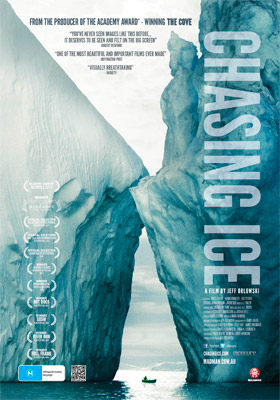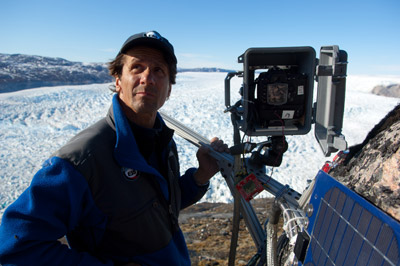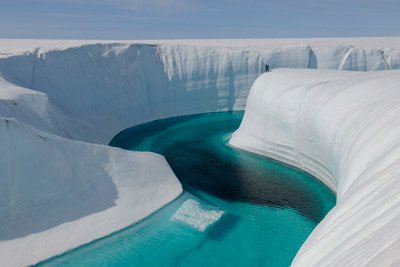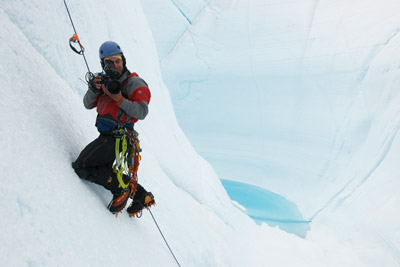Jeff Orlowski Chasing Ice Interview

Jeff Orlowski Chasing Ice Interview
Director: Jeff Orlowski
Genre: Documentary
Rated: M
Running Time: 76 minutes
Synopsis: Acclaimed photographer James Balog was once a sceptic about climate change. But through his Extreme Ice Survey, he discovers undeniable evidence of our changing planet. In Chasing Ice, Balog deploys revolutionary time-lapse cameras to capture a multi-year record of the world's changing glaciers. His hauntingly beautiful videos compress years into seconds and capture ancient mountains of ice in motion as they disappear at a breathtaking rate.
Travelling with a team of young adventures across the brutal Arctic, Balog risks his career and his well-being in pursuit of the biggest story facing humanity. As the debate polarises America, and the intensity of natural disasters ramps up globally, Chasing Ice depicts a heroic photojournalist on a mission to deliver fragile hope to our carbon-powered planet.
Chasing Ice
Release Date: April 4th, 2013 exclusive to Cinema Nova
Interview with Jeff Orlowski
 Question: Talk about how Chasing Ice came to you as a film. How did you get involved?
Question: Talk about how Chasing Ice came to you as a film. How did you get involved?
Jeff Orlowski: I was connected to James Balog through a good mutual friend, and we met on occasion in Boulder, Colorado every time I visited. I was a photographer, and a huge fan of James's work, and really wanted to work with him. In 2007, he started his project called the Extreme Ice Survey and I offered to help for free. I went with him and a team to Iceland when he started installing his first time lapse cameras, and I filmed the entire trip. It was mostly just to document what he was doing, and to have a record of the project. Then I went with him to Greenland, and then Alaska, and then kept travelling with him, filming everywhere we went.
Over time, we had collected a great archive of the project, and I knew we could make a great film out of it. There have been so many efforts to document climate change, but this one was unique As James's time-lapses started to come back from the field, we knew the project was working. So I put all my efforts into making a feature doc, built a world-class team to support me, and spent the next few years dedicated to ice.
Question: Can you talk about your relationship with James Balog and what it is about his work that you were drawn to?
Jeff Orlowski: James is an incredible mentor and friend. He's a perfectionist and will stop at nothing to create an image. But it's not just about making a photograph. For him, it's really about what the image is saying. What it means. And then how that can be communicated to the viewer. He has had a profound influence on my life, and unquestionably he's been my greatest artistic influence. I think he is one of the greatest artistic minds of our generation.
 Question: How many locations did you shoot at and how did you select them?
Question: How many locations did you shoot at and how did you select them?Jeff Orlowski: The list is too long! Greenland, Iceland, Alaska, Glacier National Park in Montana, the Alps, Bolivia, Canada... Wherever James went, we followed. James selected the locations to install his time-lapse cameras based on wanting to capture a very broad representation of glaciers all around the world. He wanted his Extreme Ice Survey to show people how glaciers are responding everywhere-not just in one small region; so we followed him everywhere.
Beyond the work in the field, we filmed scientists and experts all around the country who could help explain why James's work is so critical.
Question: What were your biggest challenges during filming?
Jeff Orlowski: The biggest challenge was the harsh environments. We had weather as low as negative 30 degrees. One winter night in Greenland, I thought I was going to freeze to death in our cabin. Our heater was leaking gas so we decided to go to sleep without it. I woke up in the middle of the night from my own teeth chattering. I rubbed my body to stay warm, and suffered until sunrise.
But as cold as it was, and as difficult as it may seem, that was all the fun stuff. I'd do it all again in a heartbeat. I'd much rather be out shooting than editing!
Question: This is your first feature length film after directing some shorts. Can you speak to how the process on Chasing Ice differed from your previous films?
Jeff Orlowski: At the beginning of this project, I had no idea how big it would eventually become. We just started shooting, and we captured what was going on. We did what needed to be done, and over time, the project got bigger and bigger. All of my previous projects were tiny compared to Chasing Ice. Even a 40-minute narrative film I made seems like cake in retrospect. There were so many times when I thought we were close to being done and then after doing a test screening, we realized that we had major structural problems, or we realised that we needed to do more interviews, or something else. It grew to a scope and a scale that was beyond the original goal, and it was so much more work than we originally expected. But it was all worth it, and our entire team is really proud of what we have created.
 Question: Chasing Ice features some very moving images of how climate change is impacting our natural world. What do you hope audiences take away from the film?
Question: Chasing Ice features some very moving images of how climate change is impacting our natural world. What do you hope audiences take away from the film?Jeff Orlowski: As James says, he wants people to realise that these images are visual evidence of climate change. His time-lapses capture that process in action. It's really hard for the average person to see the impact that humans have on the planet, especially when we live in a huge, beautiful country like America. You can drive across the States and spend days just looking out at huge open fields, and think, 'how is my little car supposed to be having some impact on all of that?"
Yet what James has documented is that visual record. . It's something that people can see and feel that represents what the science has concluded. Glaciers may seem really far away, in a distant world that nobody ever goes to, yet we humans are changing them. I hope that Chasing Ice can take James's work and make it real for people; to take the beautiful world of ice and to make it tangible and bring it close to home. If it helps change how people think about their relationship to nature, and how human beings exist on this planet, I'll consider it a success.
MORE





